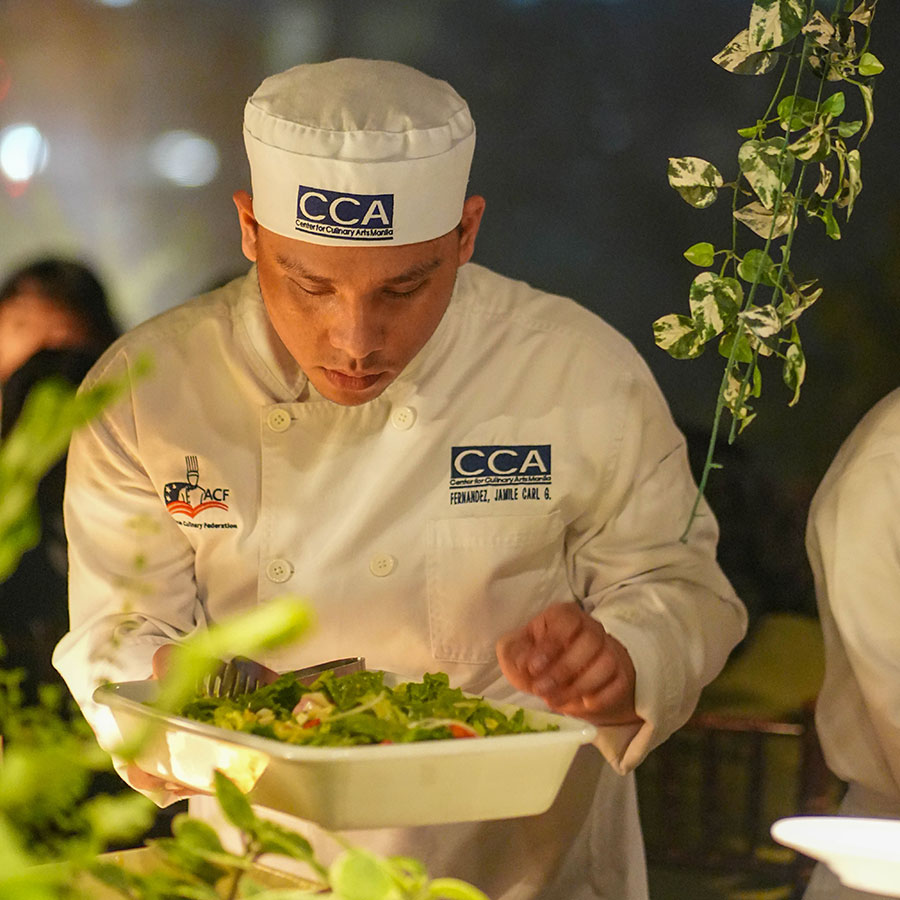CCA embraces sustainability

Culinary school looks back at 28 years of highs and lows
THE Center for Culinary Arts Manila (CCA Manila) did not celebrate its 28th anniversary in a grand manner on Nov. 26 — it didn’t even hold it in its new BGC campus. Instead, a dinner was held for guests at the BGC Urban Farms (the community garden set up in a block between some of the development’s skyscrapers), featuring a plant-based menu done in collaboration with John Danao of Green Oasis, an agri-social enterprise based in Dupax, Nueva Vizcaya.
A short talk by Veritas F. Luna, CCA Manila’s chancellor, centered on culinary wellness, with points on cultural and personal enjoyment, skillful preparation, and overlooked moderation and hydration during eating. These points were put to the test with the menu, featuring dishes like pumpkin and moringa soup, mustasa (mustard greens) salad with passionfruit vinaigrette, papaya palabok, pinakbet burrito, and tomato and ginger sorbet.
We had expectations with the pumpkin soup, which tasted comforting; complimented by its heft, but we had a pleasant surprise with the papaya palabok, the noodles in the dish substituted with shredded green papaya. The usually heavy dish became a light repast, and despite our aversion to fruit, we might look forward to seeing this at someone else’s table.
The dinner highlighted CCA Manila’s commitment to sustainability, seen in a plant-based kitchen in Tagaytay in a partnership with Guang Ming College, and in a culinary agri-entrepreneurship program in collaboration with the University of the Philippines Los Baños.
“For us, it’s really part of our DNA since CCA started,” said Badjie Trinidad, president of CCA Manila in an interview.
The school was started 28 years ago by her mother Annie Guerrero. “My mom is a culinary environmentalist,” she said, recalling that her mother told her stories about growing up in Malabon. Back then, her mother and her sisters would receive a budget from their parents, but her mother would be the only one who could come up with change by the end of the week. She did this by sourcing everything from nearby markets and their own backyard — down to their toys.
“When we started the school, she would be very strict with our chefs,” Ms. Trinidad recalled, citing that students and even faculty members would get demerits and memos for waste and other environmental issues — all this before “sustainability” had become a buzzword.
“I think employers appreciate our graduates, when they work, because they’re very mindful of their resources,” said Ms. Trinidad.
She discussed the problems they faced to get to 28 years: “One, of course, is the sourcing of ingredients. We want to give the best training but not all of the ingredients are available,” she said. Another would be hiring faculty that “both have technical and practical experience.”
There was also the pandemic, but then, “We never thought we could teach culinary online. We were never closed — maybe just for a week. But we continued and we persevered.”
“I guess we just have to persevere,” she said about how they got to 28 years. This also comes with focus: “Just focus on what we (found) that we do best, which is really culinary training.” While she said that they didn’t expand into other programs, what they did was to form new courses that only served to complement the culinary training core, with paths in entrepreneurship and food technology.
Ms. Trinidad cited the difference in the profiles of their students now, versus then. Before, they used to cater to city-based students, but a lot of their new students are from the provinces or from overseas.
She talked about their plans for the future, namely, opening 10 campuses in five years. “Fulfilling 5,000 culinary dreams — that’s the target we set for ourselves,” she said. Part of this includes upcoming partnerships with University of the Philippines Diliman, and with Brittany Hotel in BGC.
“We never stopped innovating our programs,” she said. “Just like when we started CCA. No one thought that anyone would enroll for a two-year program. They thought of it just as a hobby; a short course. Now, it’s a career.” — Joseph L. Garcia



